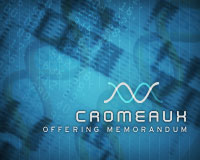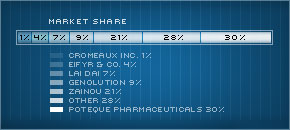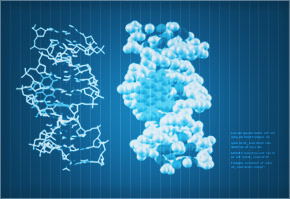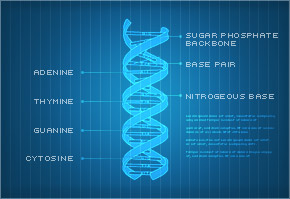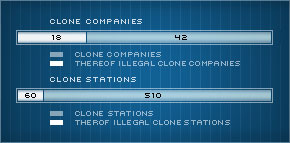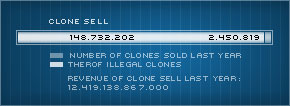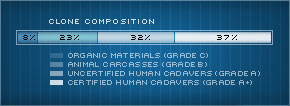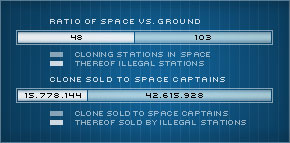Cloning
Statement of purpose
Cromeaux Inc. aims to become the largest provider of high quality clones within the Federation. The cloning business is becoming one of the most lucrative industries in the world of EVE and an innovative and vigorous company can quickly get a good turnover. Cromeaux Inc. has in recent months hired some of the best scientists in the field and intends with their help to develop further its pioneering cloning-technique to gain a sizeable market-share within the next five years. Cromeaux Inc. was founded 7 years ago as an independent division of the Chemal Tech, which owns 2/3 of the company. The rest is held by key employees (25%) and the Bank of Luminaire (8%). The funds raised in this round of finances will allow the company to grow to the level where it can start offering competitive products on a Federation-wide bases.
Business
Clones are a luxury commodity in high demand. The number of illegal clone clinics, often using inferior and even dangerous materials, clearly indicates that a substantial market is out there ready to be serviced by high quality, reliable and governmentally approved clones.
Cromeaux Inc. was founded 7 years ago by Dr. Yomir Veschens, an established expert in biochemistry and the entrepreneur Eron Jascete. Today it has more than 4.000 employees, including many of the leading geneticists and bioengineers in the world. Some of the key personnel currently employed by Cromeaux Inc. are:
- Dr. Yomir Veschens. CTO. Graduated from SWS in ’74 EST with a Ph.D. in both Biochemistry and Gene-design. Member of Dr. Jurg Akrael’s team and contributed to its successes in perfecting the brain mapping technique. Co-founder of Cromeaux Inc.
- Marika Alois. CEO. A respected manager, Alois has been director of several startup companies, including KS Manufacturing and DioSec. Became CEO of Cromeaux Inc. earlier this year.
- Daphnie Fonterouche. CFO. Former bank manager for Bank of Luminaire. Worked as an independent financial advisor before joining Cromeaux Inc. four years ago.
- Dr. Roul Gonzi. Senior Engineer. Former employee in the clone department of Poteque Pharmaceuticals, where he supervised the clone research team.
- Dr. Araham Keredin. Researcher. Dr. Keredin was a Biology professor at the Royal Institute on Amarr Prime before joining Cromeaux Inc. in the spring. He is an expert on mnemonic theories and psyche restoration.
Cromeaux Inc. already operates five cloning facilities in the Federation, all in high density, high yield areas. The company plans to open seven more facilities in the coming months, thereof four located on space stations. This is to tap into the clone demand from space ship captains, which are quickly becoming the largest group of clientele.
The largest manufacturer of clones within the Federation at the moment is Poteque Pharmaceuticals. Being the largest biotech company within the Federation Poteque made an easy transaction into the clone business as soon as the technology became financially viable and the laws for their use firm. However, the fact that the clone production is only a small subsection of the huge conglomerate means it is not a priority. Cromeaux Inc., on the other hand, by focusing solely on clones, have a unique opportunity to become a leader in the field of clone manufacturing.
Here is the current market breakdown between the largest clone companies:
- Poteque Pharmaceuticals [30%]
- Zainou [21%]
- Genolution [9%]
- Lai Dai [7%]
- Eifyr & Co. [4%]
- Cromeaux Inc. [1%]
- Other [28%]
Cromeaux Inc. intends to control 5% of the clone market in five years.
Operation
Cloning technology can be divided into three major components: clone manufacturing, brain growth & storage and clone quality. Each of these areas requires intimate knowledge and skilled staff to operate, something Cromeaux Inc. is very proud to possess in abundance.
Clone manufacturing:
Clones are manufactured using biomass. Modern methods allow pretty much any kind of biomass to be used. The best clones are constructed from human cadavers, but anything from animal carcasses to organic soups can be used. Using lower quality materials requires more extensive structuring and chemical processes and introduces a greater risk for error in the transfer of the customer's features.
At the time of purchase, the customer undergoes a thorough examination and several tissue samples are taken. This is then used to construct a clone of the customer – a clone that receives the consciousness of the original at the moment of death, granting a new life.
At Cromeaux Inc. all clones are made from certified human cadavers, all of them received from willing donors. The biomass has not been tampered with or thinned out – only highest quality preservatives have been introduced to hinder tissue decomposition. Cromeaux Inc. mission is to establish itself as the manufacturer of clones of the very highest quality and its clientele can rest assured that the underhanded tactics used by so many clone stations do not apply for its operation. All federal laws and regulations are applied rigorously, with governmental inspectors a permanent feature on all our stations.
The biomass is used to construct a functioning body. This body is complete in every sense, with fully functioning organs and peripheral neural system. Instead of a brain there is only a primitive cluster of ganglia which is capable of maintaining heart rate, blood pressure and respiration. Core body temperature is dependent on the environment, and so has to be controlled very carefully in order not to damage the cells. The immune system of the donor is crippled and the thymus is removed and replaced with implanted cells from the customer. The clone body will thus not reject any implant – this makes it possible to seed the body with stem cells from the customer. The clone’s body cells divide very slowly, allowing the new cells to take over in time.
Culturing a clone takes several months, but all clone stations store generic clones that are only put to use when a client buys it. The skull, and frequently other bones as well, is replaced by osteoplastic materials – soft synthetic bone polymers that can be shaped and then hardened by gamma laser irradiation. In this way, facial features and other body marks and textures can be applied very quickly. The process is very quick and is applied as soon as the clone is purchased. A similar technique is also used to adjust skin tones and give special skin marks, such as tattoos and scars. This means that the featureless clone is quickly transformed into an identical twin of the client.
Any respectable cloning company must take into account the physiological differences between the human races and bloodlines in existence. Each of them has unique DNA imprints that must be replicated so that the transfer process goes as smoothly and with as little deviances as possible. If done properly the unique characteristics and traits that each bloodline has can be kept intact. This is very important during the brain growth process (see below), as the memory restoration is closely linked to the exact neuro-strata layout of the brain tissue, which varies greatly from one bloodline to the next.
Brain growth & storage
Clones are never bred with an intact brain as this is obviously very much dictated by the client. Once a clone is bought a thorough brain scan is made of the client to determine the shape of the brain and the placement of nerve cell nuclei. Then a three dimensional gel structure that matches the shape of the client's brain is constructed.
The cranium is constructed by seeding this gel structure (heavily impregnated with nutrients and inactivated growth factors) with nerve cells and glia, in accordance with information from the brain scan. Bound to the growth factors are molecular receptors that are coupled (using the well known FTL-communication technology) to molecules placed in the customer's burning scanner (see Clone quality, below). After seeding, the gel structure is suspended until the final moment of the original. As the burning scan is made, the molecules bound to the inactivated growth factors become unstable and cause activation of the growth factors by cleavage. The activation is an exothermic process which produces sufficient heat to melt pathways into the gel model of the brain. Thus dendrite paths in the model will be the same as in the original's brain, their growth fuelled by the activated growth factors.
This process alone is not sufficient for an exact replica of the original's brain. The precise shape of the dendrites and the potentiation level of the synapse, which together determine memories and skills, have to be fine tuned through a neural link. Impulses are sent through the link to stimulate further growth and shaping of the dendrites, until they fill in the paths formed with the activation process. In the final stages of this tuning, as the clone regains consciousness, potentiation at synapses is quickly adjusted to recorded levels, generating a feeling often described as one of memories "coming back".
Clone stations store client clones (also termed readied clones) as well as still-to-be-used featureless clone bodies. The cloning process is always on a one-to-one basis, as the molecular receptors bound in the gel structure are coupled to the burning scanner carried by the customer. Premium members will of course always have clone copies of themselves in every Cromeaux Inc. clone facility – service that Cromeaux Inc. pioneered when it started and has since been imitated by all the other major clone companies – but as there is only one burning scanner for each clone, they will have to use a scanner that is coupled to a clone in a facility close to their current position.
In the final stages of this tuning, as the clone regains consciousness, potentiation at synapses is quickly adjusted to recorded levels, generating a feeling often described as one of memories "coming back".
Clone quality
The moment the capsule sensors detect a breach in the capsule they activate the emergency uploading of the mind of the person in the capsule, as described above. The capsule makes an analog scan of the brain of the person. This extraordinary snapshot records the exact state of the mind, including every neuron connection between every brain cell. Because the scan must be instantaneous and efficient it brutalizes the brain in the process. In early tests, the subjects were left with permanent and severe brain damage after being scanned, a fact that is impossible to escape. But as the person is about to die in any case, this unfortunate side effect has little consequences. All modern capsules are highly tuned to when to take the snapshot – if it is done too early there is a chance that the subject will not die at all, but live on in a vegetative state. And if the snapshot is taken too late there is the risk that the scan will fail or even that the revived clone will remember its own death, a very traumatic experience that can introduce severe psychological and functional problems in the clone.
The quality of the clone is always critical and this is a point that cannot be stressed enough. The closer the clone’s brain is to the original in shape and form the better the reviving process will work. The more different they are the more memory will be lost during the synaptic growth process. This is most clearly seen in the space industry. For a space captain to retain his license he must be connected to a cloning facility. But if he fails to buy himself a suitable clone, which he is not required to do by law, he will be given a generic clone instead at the time of death. As these generic clones are bound to have very different brains than the original the memory loss can be very severe. The best clones, made from certified human cadavers in perfect condition, are able to retain up to 99.99% of memory – a figure close enough to call the revived clone a true doppelganger of the original person.
Market analysis
The cloning clientele has risen steadily for the last several years. There are several reasons for this:
- New cloning techniques that are cheaper and easier to employ.
- Increased visibility of cloning stations due to competition.
- Increased number of space captains – the single largest customer group.
- New laws and regulations in allowing the use of clones in areas where it was impossible before.
- Cloning no longer considered a risky experiment or a social taboo in most areas.
It is impossible to know with any certainty the size of the clone market due to excessive number of illegal or hidden clone stations. Although many of these illegal stations produce inferior clones they still steal a lot of potential customers from the legal clone stations. To be fair, these illegal stations do provide a service to people that would be denied service in any respectable cloning facility. Here is break down of various stats of the clone market today, note that numbers are not totally accurate due to lack of information from illegal stations:
Clone companies:
- Total number of clone companies [42]
- Thereof, illegal companies [18]
- Total number of clone stations [510]
- Thereof, illegal stations [60]
Selling clones:
- Total number of clones sold last year [148.732.202]
- Thereof, illegal clones [24.450.819]
- Total revenue from clone sell last year [12.419.138.867.000]
Clone composition:
- Certified human cadavers (Grade A+) [37%]
- Uncertified human cadavers (Grade A) [32%]
- Animal carcasses (Grade B) [23%]
- Organic materials (Grade C) [8%]
Ratio of space vs. ground:
- Number of cloning stations in space [103]
- Thereof, illegal stations [48]
- Number of clones sold to space captains [42.615.928]
- Thereof, sold by illegal stations [15.778.144]
As can be seen in these figures the space industry is proportionally very big considering that space farers are only a fraction of the total population in the world. This is understandable as space captains are the only profession required by law to do business with a clone station, not to mention the many hazards of space faring, which time and again has demonstrated the need for such a law. The space industry is also the fastest growing industry there is. Planetary clone stations increased their sale last year by 3% on the average, while clone facilities on space stations increased their sale on the average by a whopping 11% during the same period.
Income project and future prospects
The first 2 years Cromeaux Inc. focused on research & development. The first clone facility was opened in the third year and since then another clone station has been added every year. With the first clone station came the first earnings, but last year was the first one that earnings matched spending. This means that the business has stabilized and a solid foundation has been created for further expansion. The new funding will allow Cromeaux Inc. to expand its operation to space, which, as has been demonstrated, is where the clone industry is growing fastest. Of the seven new clone facilities that are planned, four will be located in space – the company has already secured very promising sites for these stations, all in high traffic systems. These stations are expected to become the heart of Cromeaux Inc.’s operation. These sites are on the following stations:
- Miroitem II
- Reblier Prime
- Deven I
- Colcer II
The projected earnings of the company once these seven stations are up and running is expected to quadruple. At the same time the cost of running the company is expected to double. Thus, in 2 years time, a profit of between 1-2.000.000.000 is expected.
The board of Cromeaux Inc. considers that the risks involved in this expansion are minimal, while the potential payoff is huge for all investors involved.
